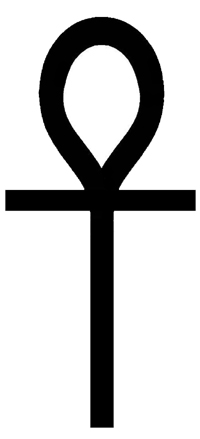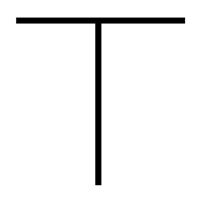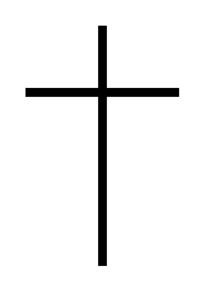The Cross of Life

The First Use of the Cross in
Ancient Religion

By: David Deschesne
Editor/Publisher,
Fort Fairfield Journal, January 3, 2018
6,000 years ago, and 4,000 years before Christ, the religious beliefs of Kemet, now known as ancient Egypt, incorporated a cross into its dogma as thoroughly as the Latin cross of Christians today.
The symbol, pictured above, was known as the ankh and was featured in its own hieroglyph as a cross topped off with a loop. As a hieroglyph it meant life in general, as a religious symbol it meant much more.
The ankh was used in the religious ceremonies of ancient Egypt to symbolize resurrection from the dead and everlasting life 4,000 years before the Christian community incorporated a variation of it as their religious trademark. The ankh was used extensively in the funerary rites of the ancients long before the books of the Torah and Old Testament were even thought of; certainly for millennia before Christianity. It was known variously in Kemet as the “Cross of Life,” the “Key of Life,” or the “Key of the Nile.”
Papyrus scrolls of the funerary rites of ancient Egypt dating over 1,400 years before Christ have been found and are replete with imagery of the ankh as it relates to the soul’s journey through the underworld, its judgment at the judgment seat of Osiris and ultimately its resurrection into the afterlife in the Fields of Peace, also known as the Field of Reeds. These rites were codified in what is now known as the Egyptian Book of the Dead.
The Book of the Dead was composed by priests and scribes for pharaohs and eventually other wealthy individuals to aid them in their journey through the underworld so that they would be successful in attaining everlasting life. The ankh is seen prominently displayed in many cases on the boat that is transporting the newly deceased soul through the Duat. It is also depicted with Osiris, the judge of the underworld and the first god-man to be resurrected in the known history of Kemet’s religious mythos (other god-men avatars such as Rāma and Krishna [KRSNA] originated with the much older Hindu religion of Persia but are outside the scope of this subject). Osiris’ wife, Isis also is shown in some picture-texts displaying the ankh. During the time of Amenhotep IV, a/k/a Akhenaten, The sun-god, Aten is depicted in ancient artwork as presenting the ankh by reaching out and clutching it with his rays, offering it to the dead in order to restore their “breath of life” and thus resurrect their soul. Akhenaten was the first—and only—ancient Egyptian pharaoh to advance the idea of one supreme God and enforce a monotheistic religion. (Researcher, Ahmed Osman has even advanced the theory that the story of Moses in the Torah and Old Testament is actually an interpolation or adaptation of the Akhenaten story where Akhenaten is the true, historical Moses rewritten as a Jewish story. His book is cited in footnote #3, below.)
The ankh is believed to be a symbol representing the union of the male and female sex, with the oval representing the female genitals and the lower part of the cross representing the male phallus. As the Key of the Nile it symbolized the sacred union of the God and Goddess that was supposed to take place at the source of the Nile river each year. It was regarded in the ancient Egyptian religion as a universal life-charm.1
The ancient Egyptians believed the ankh included the three basic powers of creation within its symbolism. Those powers were: Emen-Ra, Reh, and the primordial waters called Nu, from which all physical creation was formed.2 The imagery of these waters of Nu closely parallels the “waters” which God’s spirit hovered over in Genesis 1:2.
The Cross in Early Christianity

During the time the Gospels were being written, the idea of Christianity as a religion was in its infancy. There were various competing sects, from the Ebionites, who adopted a more Judaist approach to Christ; the Gnostics, who believed the Christian story they were writing was an allegory based upon known spiritual mystery religions of the time; to finally, the Orthodox Christians who presented the Christian narrative as a true, historical account of events.
Those three competing Christian ideas and narratives coexisted for the first three hundred years A.D. It’s been suggested that during the early years, it was the Egyptian ankh that Paul was referring to in his writings because it symbolized life, not punishment or death.3 The early Christians also occasionally used the ankh as an emblem of immortality, calling it an ansated cross (a cross with a handle).4
For the first few centuries A.D. it was also the headless T Tau Cross, rather than the traditional Latin cross of today, that Christians used to represent their sect.5
The Gnostics looked at the cross more as a symbol, than a literal physical punishing device as the traditional literalist Christians do, today. To the Gnostics, the cross represented the four elements of the physical world—earth, water, air and fire. The figure of a man nailed to a cross would then be symbolic of humans’ sensual desires which attach the soul to the world of those four elements, thus enslaving it in the prison of a fleshly body.6 In this respect the Gnostics didn’t treat the story of Jesus as an actual literal, historical account, but rather as a spiritual allegory where the soul dies and is imprisoned in flesh in the physical realm, to be eventually redeemed by a savior who separates them from that cross and restores them to their former glory with the godhead. The Ebionites and Gnostics were ultimately declared “heretics” by the Orthodox Christian church which, after the Council of Nicea, began enjoying the police power of the Roman government to enforce its “official” historical narrative and these competing narratives were ultimately lost, until recently. The orthodox, Roman Christians also made their way into Egypt and in many temples where the ankh was carved in stone they chiseled out the top loop and left the cross appearing as a rudimentary Tau cross. This was presumably done in order to erase the true origins of their Christian cross and sever potential linkage with Egyptian origins.

It wasn’t until between 300-400 A.D. that the Latin Cross we are familiar with today began being used by Christians. The crucifix, or Roman Cross, which is essentially a Latin Cross containing the image of the crucified Christ, didn’t become popular until after the 7th century A.D.7
Notes:
1.) The Woman’s Encyclopedia of Myths and Secrets, ©1983 Barbara Walker, p. 38
2.) The Illustrated Egyptian Book of the Dead, ©2001 Dr. Ramses Saleem, p. 41
3.) Christianity: An Ancient Egyptian Religion, ©2005 Ahmed Osman, p. 203
4.) The Woman’s Encyclopedia of Myths and Secrets, p. 38
5.) op cit. p. 188.
6.) The Jesus Mysteries, ©1999 Timothy Freke & Peter Gandy, p. 52; see also, The Pagan Christ, ©2004 Tom Harpur, p. 45
7.) Funk & Wagnalls Standard Dictionary of Folklore, Mythology, and Legend, ©1972 Harper & Row, p. 265








